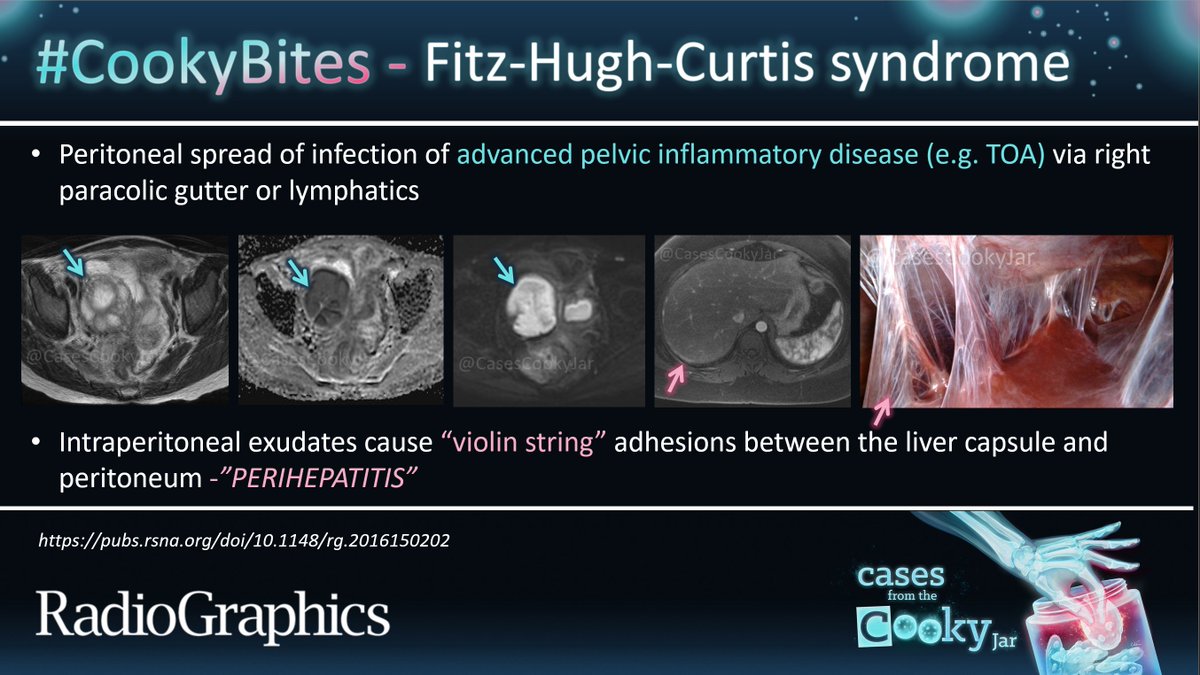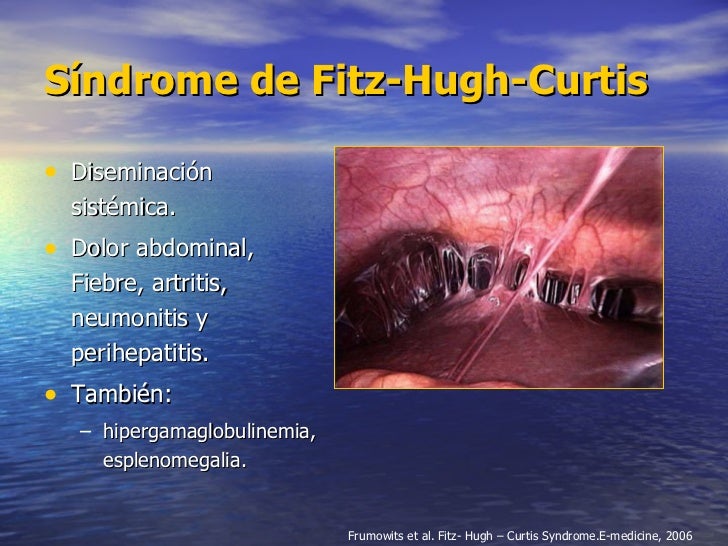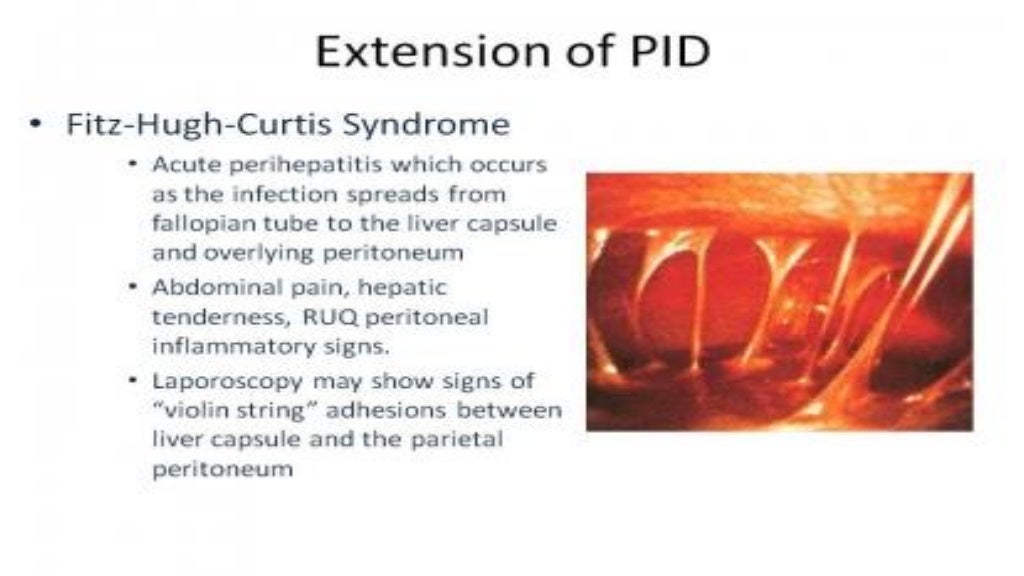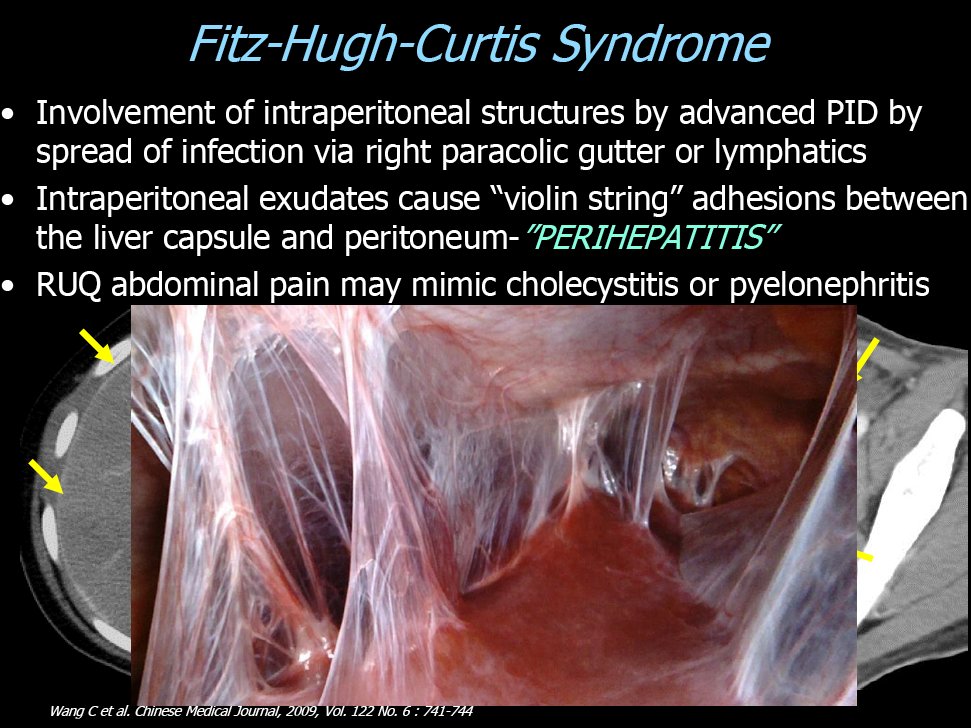
Fitz Hugh Curtis Ultrasound
Fitz-Hugh-Curtis syndrome (FHCS), or perihepatitis, is a chronic manifestation of pelvic inflammatory disease (PID). It is described as an inflammation of the liver capsule, without the involvement of the liver parenchyma, with adhesion formation accompanied by right upper quadrant pain. A final diagnosis can be made through laparoscopy or.

FitzHughCurtis syndrome lacking typical characteristics of pelvic inflammatory disease BMJ
Fitz-Hugh-Curtis syndrome is considered a rare complication of pelvic inflammatory disease, mostly associated with C. trachomatis. The right upper abdominal pain appears as the main symptom and becomes more severe in response to deep breathing and body movements. Occasionally, the pain may radiate to the right shoulder.

What is Fitz Hugh Curtis SyndromeCausesSymptomsTreatment
Fitz-Hugh-Curtis syndrome in adolescent and young adult females: Utility of a decision rule, The American Journal of Emergency Medicine, 50, (183-186),.

(PDF) FitzHughCurtis syndrome lacking typical characteristics of pelvic inflammatory disease
Fitz-Hugh-Curtis syndrome is a rare complication of pelvic inflammatory disease (PID) involving liver capsule inflammation leading to the formation of adhesions presenting with the clinical syndrome of right upper quadrant (RUQ) pain. History.

Fitz Hugh Curtis Ultrasound
El síndrome de Fitz-Hugh-Curtis es una inflamación de la cápsula hepática, como complicación de una enfermedad inflamatoria pélvica, cuyo agente etiológico más frecuente es la C. trachomatis. La fase aguda del síndrome de Fitz-Hugh-Curtis puede presentarse con dolor en cuadrante superior derecho del abdomen, confundiéndose comúnmente.

Linfogranuloma venereo y Donovanosis
Introducción. El síndrome de Fitz-Hugh-Curtis (SFHC) se define como una perihepatitis asociada a enfermedad pélvica inflamatoria (EPI), que afecta a la cápsula hepática y al peritoneo adyacente, bien por infección directa ascendente, o por fenómenos inflamatorios locales[].Afecta principalmente a mujeres en edad fértil[], [], con un cuadro clínico de dolor en hipocondrio derecho en.

FitzHughCurtisSyndrom pacs
Fitz-Hugh-Curtis syndrome is characterized by inflammation of the liver capsule and the production of adhesions, leading in pain in the right upper quadrant. It is a rare chronic form of pelvic inflammatory disease that affects women of childbearing age. Curtis described adhesions between the anterior surface of the liver and the abdominal wall.

¿Cuáles son los síntomas del Síndrome de Fitz Hugh Curtis?
INTRODUCTION. Fitz-Hugh-Curtis Syndrome (FHCS) is characterized by inflammation of the perihepatic capsules associated with pelvic inflammation, without involvement of the hepatic parenchyma. 1, 2 A definitive diagnosis can be made based on detection of violin string-like adhesions or identification of causative organisms in hepatic capsular lesion specimens, which requires laparoscopy or.

Fitz Hugh Curtis Syndrome
Fitz-Hugh-Curtis syndrome (FHCS), or perihepatitis, is a chronic manifestation of pelvic inflammatory disease (PID).[1] It is described as an inflammation of the liver capsule, without the involvement of the liver parenchyma, with adhesion formation accompanied by right upper quadrant pain. A final diagnosis can be made through laparoscopy or laparotomy via direct visualization of violin.

FitzHughCurtis (FHC) syndrome Medicine Keys for MRCPs
Introduction. Le syndrome de Fitz-Hugh-Curtis (FHC) ou périhépatite vénérienne correspond à une atteinte inflammatoire périhépatique capsulaire et péritonéale secondaire à une infection pelvienne. Ce syndrome a été rapporté pour la première fois en 1919 par Stajano, redécouvert par Curtis en 1930, puis par Fitz-Hugh en 1934 qui.

Fitz Hugh Curtis syndrome causes, symptoms, diagnosis, treatment & prognosis
Introducción. El síndrome de Fitz-Hugh-Curtis (SFHC), también conocido como perihepatitis, es una complicación poco frecuente de la enfermedad pélvica inflamatoria (EPI), con una incidencia variable en función de los criterios diagnósticos utilizados 1, 2.Este síndrome consiste en una inflamación de la cápsula hepática y el peritoneo adyacente, sin compromiso del parénquima.

fitz hugh curtis syndrome,what to know?
Fitz-Hugh-Curtis syndrome (FHCS), also known as perihepatitis, is a rare complication of pelvic inflammatory disease (PID) that occurs in 10% of women with PID, characterized by inflammation of the liver capsule with associated abdominal pain [ 1, 2 ]. It is generally associated with PID due to chlamydia or gonococcal infections [ 1, 3 ].
FitzHughCurtis syndrome 네이버 블로그
Citation, DOI, disclosures and article data. Fitz-Hugh-Curtis syndrome (FHCS), or perihepatitis, is the inflammation of the liver capsule and overlying peritoneum associated with adhesion formation, without the involvement of the hepatic parenchyma. It is a chronic complication of pelvic inflammatory disease (PID).

(PDF) FitzHughCurtis Syndrome
Fitz-Hugh-Curtis syndrome (FHCS), also known as perihepatitis, is a rare complication of pelvic inflammatory disease (PID), with a variable incidence depending on the diagnostic criteria used. 1, 2 This syndrome consists of the inflammation of the liver capsule and the adjacent peritoneum, without involvement of the liver parenchyma as a result.

(PDF) FitzHughCurtis syndrome associated with tuberculous salpingitis and peritonitis A case
The main symptom of Fitz-Hugh-Curtis syndrome to watch for is abdominal pain in the upper right quadrant, just below the ribs as this can indicate inflammation of the liver capsule, or tissue.

Asymptomatic FitzHughCurtis Visualized like Violin String during Gynecologic Laparoscopic
Fitz-Hugh Curtis syndrome is a rare cause of RUQ pain in reproductive-aged female patients and consists of perihepatitis complicated by cervicitis or pelvic inflammatory disease. Increased enhancement along the hepatic surface on biphasic contrast-enhanced CT has a high sensitivity and specificity of about 90% each for the disease. 1.
- Dia Nacional Do Oficial De Justiça
- Caruso Todo Mundo Odeia O Chris Vida Real
- Animes Para Maiores De Idade
- Mandado De Citação Expedido O Que Significa
- Eta Mundo Bom Audiência Detalhada
- Livro De Oração De São Cipriano
- Chris Martin E Gwyneth Paltrow Filhos
- Gentílicos Dos Estados Do Brasil
- João Miranda De Souza Filho
- Falta De Proteina No Corpo